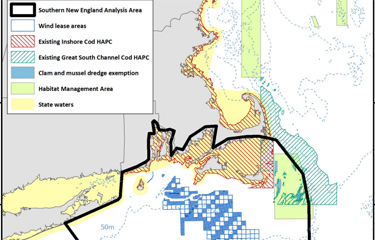Concern over the impact of offshore wind energy development – and potentially aquaculture in federal waters – has the New England Fishery Management Council preparing a Habitat Area of Particular Concern (HAPC) in southern New England to focus on cod, scallops and other species that rely on essential fish habitat south of Cape Cod.
During its 1 to 3 February meeting, the council initiated a framework adjustment to develop the new HAPC, with a goal of having it ready in April 2022.
According to a council summary, HAPCs “emphasize the importance of specific areas and habitat features, and strengthen the basis for conservation recommendations designed to avoid, minimize, and mitigate impacts on habitat.”
In a presentation to the council, its habitat committee said a new HAPC in Southern New England “is needed to provide conservation focus for specific New England Council-managed species with [essential fish habitat] in the area.”
With Vineyard Wind undertaking construction of a 800-megawatt project and neighboring leaseholders moving forward, the council said offshore wind development is its most-immediate concern. The council also expressed concern about the potential for offshore aquaculture development in New England, with some companies exploring how to raise Atlantic salmon and other species off the coast. Of particular concern to the council is a proposal by Running Tide Technology to grow kelp on the northwestern part of Fippennies Ledge in the Gulf of Maine.
“This is due to concerns about impacts from offshore development, specifically offshore wind in the near term, and possibly offshore aquaculture, in the future,” it said.
A 15 February letter from the council’s executive director, Tom Nies, to the U.S. Army Corps of Engineers outlined the council’s concerns regarding Running Tide project, which hopes to operate 30 vertical lines with 15 separate moorings, with each line attached to a 30-foot chain and 600-pound concrete block anchor. A public notice for the project describes the affected area as less than a quarter of an acre in size, but Nies’ letter suggested it could be closer to two acres.
“Our understanding is that this project is a multi-year pilot effort to test environmental sensors and measure kelp growth rates under offshore conditions. Their longer-term plans are to develop and deploy floating kelp growing platforms much farther offshore, which will eventually sink and sequester carbon in the deep-sea,” Nies wrote. “While this longer-term work is not part of this permit application, we think it would help explain the need for the pilot project in relation to Running Tides’ long-term objectives … Explaining the nature and duration of the project may help to allay fishing industry concerns.”
The council expressed concerned the ocean floor might be damaged by the moorings and anchors moving, according to the letter. Fippennies Ledge is managed as a habitat closure that prohibits bottom-tending mobile gear.
“We do know that the area is fished by for-hire charter boats targeting both groundfish and highly migratory species, and some of the captains have expressed concerns about the need to avoid the vertical lines,” Nies wrote. “If the permit is issued, it will be important for Running Tide to clearly communicate the location of each mooring and the timing of installation. We suggest requiring a fisheries communications plan as a condition of the permit.”
Image courtesy of New England Fishery Management Council







